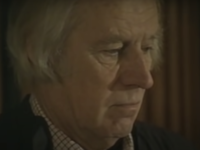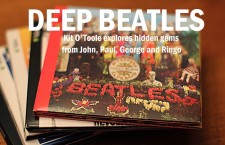Sporting crisp white shirts and ties, his short haircut perfectly groomed, George Martin’s appearance did not scream “rebel.” Indeed, his calm demeanor and upper-crust accent portrayed him as the quintessential English gentleman, quietly commanding respect from everyone who worked with him.
Little did people realize that Martin was in fact one of the biggest risk-takers in the music industry, taking a chance on a band that had been turned down by other labels. Realizing their potential and enabling them to share their creative vision with the world, George Martin helped make the Beatles a tremendous artistic force still unmatched today. His journey to becoming the “Fifth Beatle,” as Paul McCartney dubbed him, gradually revealed him as a producer with a maverick streak. When John Lennon informed Martin that he wanted to sound like “I’m the Dalai Lama singing from the highest mountain top” in “Tomorrow Never Knows,” Martin did not scoff at Lennon’s idea but created that very effect.
A classically trained musician and composer, George Martin first worked in the BBC’s classical music department before joining EMI/Parlophone in 1950. At first Parlophone was regarded as a small subsidiary of the company, with lesser-known acts being relegated to the label. However, when Parlophone head Oscar Preuss retired in 1955, Martin took over to rebuild it into a more prominent label. Given his background, it was not surprising that Martin oversaw classical and Baroque music recordings. He quickly demonstrated a hidden talent when he also produced comedy recordings, working with such British luminaries as Peter Sellers, Spike Milligan, Peter Cook and Dudley Moore.
Bolstered by the success of such albums as Sellers’ Songs for Swinging Sellers, the Goon Show’s The Bridge on the River Wye, and the cast recordings for Beyond the Fringe and That Was the Week that Was, Martin wanted to break into the rock and pop market. It was at this career crossroads that the Beatles entered George Martin’s professional life.
After achieving modest success with pop records, Martin sought a band that would establish Parlophone as a bigger label — and, in turn, cement Martin’s growing reputation as a producer. In 1962, the Beatles and their manager Brian Epstein had also reached a crossroads, running out of record companies to approach. The group had been famously turned down by Decca; after retrieving the Decca audition they had recorded, Epstein circulated the tape through various channels. He finally attracted the ear of music publisher Sid Coleman, who passed the tape on to Martin.
While not initially bowled over by the Beatles’ technical ability, he was intrigued by John Lennon and Paul McCartney’s voices. After meeting with Epstein, Martin agreed to an audition. Thus on June 6, 1962, the Beatles recorded four songs, with Martin listening to the tape at the end of the session. It was a decidedly mixed verdict: the producer disliked the drummer, Pete Best, and was unimpressed by Lennon and McCartney’s early compositions. Yet the risk-taker inside believed the Beatles possessed a special charisma that, with time, could translate into quality music.
Martin’s formal appearance may have intimidated some new artists, but the Beatles showed little reverence. When Martin asked the group if there was anything they did not like about the session, George Harrison cheekily replied “well, there’s your tie, for a start.” The ice broken, Martin signed the group, and their close collaboration began.
In the early years of rock, most artists did not write their own material. Instead, label heads would dictate what they would record; grateful for any opportunity, bands would cheerfully acquiesce. During their first recording session with George Martin on September 4, 1962, the Beatles signaled that they would break this unwritten rule. When Martin presented them with the surefire hit “How Do You Do It,” the group initially refused to record the song, insisting that they had written better material.
Most producers would have balked at the Beatles’ nerve; indeed, Martin did persuade them to perform the track. But when Lennon and McCartney brought in “Please Please Me,” Martin reconsidered his stance. In an early example of the special collaborative relationship he shared with the group, he suggested that the Beatles change the tempo from a Roy Orbison-type ballad into an uptempo pop track. After they completed recording the song on November 26, 1962, Martin made the now famous announcement: “Gentlemen, you have just made your first No. 1 record.”
From that moment until the Beatles’ 1970 breakup, George Martin trusted the group’s judgement in a way few other producers would have contemplated. Rather than rein in their creative impulses, Martin would enable them, even suggesting radical changes of his own. When they struggled with “Yesterday,” Martin realized that a string arrangement would better accompany the delicate lyrics. Paul McCartney resisted the suggestion, fearing that rock audiences would ridicule the Beatles for injecting classical music elements into rock and roll.
Ultimately, Martin’s string quartet arrangement transformed the song into an instant classic, proving that rock could encompass different styles and that fans would willingly accompany the Beatles on their artistic travels. Once again, Martin’s risk-taking tendencies would help shape the band’s sound and elevate rock to an art form.
By 1965, Martin and the Beatles had grown accustomed to working together. Although the group still held enormous respect for their producer, they had become true collaborators. In fact, Martin often served as a musician as well as the “behind the scenes” guide. When recording “In My Life,” the Beatles hit a roadblock when they remained undecided on the middle solo. Martin solved the problem while the boys enjoyed a tea break; he played a Baroque piano solo, but wanted it to sound like a harpsichord. Thus, he recorded the piano at half-speed; when the part was played at normal speed, the solo was an octave higher and twice as fast.
Once John Lennon heard the result, he left Martin’s section in the final version. That solo remains one of the track’s most distinctive and memorable features, one that would not exist without George Martin’s ingenuity, technical knowledge and classical training.
Martin’s nonconformist attitude particularly surfaced on Sgt. Pepper’s Lonely Hearts Club Band, when his ability to create unusual tape loops and merge Eastern and Western genres further proved his love of musical experimentation. In The Complete Beatles Recording Sessions, Martin told author Mark Lewisohn that Sgt. Pepper marked a distinct change in his producing role: “By 1967, we were building sound pictures and my role had changed: It was now to interpret those pictures and work out how best to get them down on tape.”
As the Beatles began work on “Being for the Benefit of Mr. Kite!” Lennon informed Martin that he wanted listeners to “smell the sawdust on the floor” as they lost themselves in the track’s carnivalesque atmosphere. At first Martin sought out a calliope, or a steam organ. When he failed to find a suitable instrument, Martin decided to create the sound using Abbey Road equipment.
“If you go to a fairground, shut your eyes and listen: rifle shots, hurdy-gurdy noises, people shouting and — way in the distance. Just a tremendous chaotic sound,” Martin told Lewisohn. So, he found old tapes of a calliope playing Sousa marches, cut them up sections, and asked engineer Geoff Emerick to throw them up in the air. Martin and Emerick then reattached the sections, resulting in the cacophonous sounds heard on the final recording. Without that ingenuity, “Being for the Benefit of Mr. Kite!” would lack that insanely chaotic sound that perfectly suits the song’s subject. Listeners could indeed smell the sawdust.
Another Sgt. Pepper track, “Within You Without You,” required Martin to score strings to complement the Indian instruments previously recorded during Harrison’s recent trip to India. Conducting eight violinists and three cellists, he had them mimic and accompany instruments such as the sitar and dilruba (a sitar-like instrument played with a bow). Western ears unaccustomed to such sounds may have unfairly rejected the exotic music without Martin’s strings grounding the song in Eastern classical traditions.
The sweeping, lush arrangement seamlessly fused the two musical genres, effectively introducing Beatles fans to a different — and beautiful — sound. Once again, George Martin’s ability to interpret George Harrison’s “sound pictures” demonstrated how he served an important function in the Beatles’ music — enabling them to accurately express their creative vision.
In the 1992 documentary The Making of Sgt. Pepper, Harrison perfectly summarized the Beatles’ relationship with Martin: “I just think we grew through those years together — him as the straight man and us as the loonies. He was always there for us to interpret our strangeness.” Both a gentleman and a rebel, Martin possessed an important quality: trusting in an artist’s judgment and working toward making their ideas a reality.
Rather than dictate, the producer allowed the Beatles to be themselves. He may have dressed formally, but his sense of humor and open-mindedness suggested a more complex personality. Without his maverick streak, the Beatles may have never become one of the most influential bands in modern music. As Paul McCartney said in his touching tribute, George Martin more than earned the title of the “Fifth Beatle.”
- The Rescued Early Paul McCartney Song That Completed ‘Beatles For Sale’ - December 4, 2024
- A Rare Beatles Cover Proves John Lennon Was Wrong About His Voice - November 26, 2024
- How John Lennon Came Roaring Back on the Beatles’ White Album - November 22, 2023





may i also name a few things, that without him, there would be no Beatles.
Other producers would have forced the band to have a lead singer. Probably Paul, possibly John.
He allowed them to dictate who was going to be the lead singer (except on Love Me Do because John needed to play Harmonica). George got his songs, and Ringo his.
He arranged the album track listing. Some how he made them work. Certainly through Rubber Soul, it was he that picked the order. And for the most part, you can’t quibble with the track order of any of the albums.
He also always picked the right takes and edits for each song. We’ve all heard the outtakes. Is there ANY Beatle outtake that is better than the official version? I have never heard one.
Plus, because they were ‘scared’ of him, and respected him, they never got too out of hand in the studio. Imagine John Lennon with a producer who he would’ve intimidated? disaster.
Without these and everything you mentioned above…there would be no Beatles as we know it and revere.
Absolutely agree–thanks for sharing your insights!